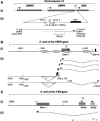Chromatin remodeling in the noncoding repeat expansion diseases
- PMID: 18957431
- PMCID: PMC2658035
- DOI: 10.1074/jbc.R800026200
Chromatin remodeling in the noncoding repeat expansion diseases
Abstract
Friedreich ataxia, myotonic dystrophy type 1 and 3 forms of intellectual disability, fragile X syndrome, FRAXE mental retardation, and FRA12A mental retardation are repeat expansion diseases caused by expansion of CTG.CAG, GAA.TTC, or CGG.CCG repeat tracts. These repeats are transcribed but not translated. They are located in different parts of different genes and cause symptoms that range from ataxia and hypertrophic cardiomyopathy to muscle wasting, male infertility, and mental retardation, yet recent reports suggest that, despite these differences, the repeats may share a common property, namely the ability to initiate repeat-mediated epigenetic changes that result in heterochromatin formation.
Figures


References
-
- Orr, H. T., and Zoghbi, H. Y. (2007) Annu. Rev. Neurosci. 30 575–621 - PubMed
-
- Fry, M., and Usdin, K. (2006) Human Nucleotide Expansion Diseases, Springer-Verlag GmbH, Heidelberg, Germany
-
- Wells, R. D., and Ashizawa, T. (2006) Genetic Instabilities and Neurological Diseases, Elsevier Ltd., Oxford
-
- Gecz, J., Gedeon, A. K., Sutherland, G. R., and Mulley, J. C. (1996) Nat. Genet. 13 105–108 - PubMed
-
- Gu, Y., Shen, Y., Gibbs, R. A., and Nelson, D. L. (1996) Nat. Genet. 13 109–113 - PubMed
Publication types
MeSH terms
Substances
LinkOut - more resources
Full Text Sources
Other Literature Sources
Medical
Miscellaneous

